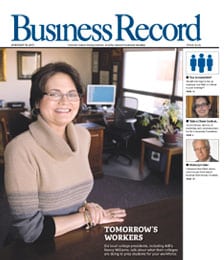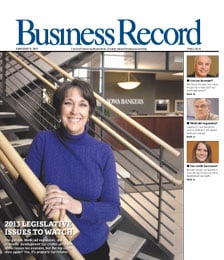Iowa ‘fund of funds’ changes investment approach

“Hey brother, can you spare $5 million? … OK, how about $2 million?”
Finding sources of venture capital — investors willing to stake an equity position in a risky start-up company in return for profitably cashing out in five to seven years — is particularly tough in Iowa, where there are few, if any, single sources willing to make these types of high-dollar investments.
This fall, Iowa is moving forward with a second attempt to create a private venture capital “fund of funds” that will be able to spread the risk of sinking seed money into start-up companies. This time, however, it’s more closely following the lead of Oklahoma, whose fund of funds has generated $95 million in venture capital investments in that state since its inception in 1993.
The Iowa Capital Investment Corp., authorized by the Legislature in 2002 to create new venture capital sources for Iowa businesses, was based on Oklahoma’s model. It initially set a goal to raise $150 million in venture capital through equity investments. However, the fund manager hired to solicit the funds, Davenport-based Great River Capital LLC, was unable to find sufficient investors to meet its goal of raising at least $75 million by mid-year. In June, Great River submitted its resignation to the ICIC.
Now, through a new fund manager, the U.S. Partnership for State Investment, the ICIC is moving forward with a plan that calls for selling state tax credits to large institutional investors and then using those subscriptions to guarantee loans to jump-start the fund — an approach more closely following Oklahoma’s model. Once the fund has gained some momentum, organizers believe it will begin attracting equity investments as well.
“My expectation is that we would be ready to make the first deployment of funds probably by April of next year,” said Dennis Murdock, chairman of the five-member panel appointed by Gov. Tom Vilsack to oversee the creation of the fund of funds.
The new model calls for obtaining commitments from institutional investors to buy state tax credits, if necessary. Those commitments will then be bundled together by the USPSI to obtain loans from banks to form what the ICIC hopes will eventually become a $100 million line of credit available to invest in venture funds.
“Obviously we don’t withdraw any of it until we’re ready to invest,” Murdock said. “At the same time, we are still out there trying to find equity investors. If we got $20 million in place with borrowed money, and two days later we’ve got a significant equity player that wants to invest $50 million, we would pay off that line of credit immediately. It allows us more flexibility in attracting equity capital. But we aren’t going to run this thing long term on borrowed money.”
Borrowing the money “lets us get off to a faster start,” said Des Moines attorney John Shors, who has served as ICIC’s general counsel since its inception. “And we do want to get this off the ground.”
Murdock and Shors are also coordinating a related effort to raise approximately $100 million in additional funds that would be backed by federal tax credits. A consortium of about 20 banks have pledged to collectively invest more than $160 million if the credits are obtained. The tax credits are awarded competitively by the federal government to community development organizations through an annual application process.
Although it has rewritten its road map, the ICIC’s destination for the fund of funds remains the same, Murdock said,
“It’s focused on a long-term success: to create a significant platform for venture capital in the state of Iowa,” he said. “The strategy was to produce the resource — a contingent tax credit — to spur investments to create a fund of funds. These funds would not be required to invest in Iowa companies. But by selecting which funds to invest in, those funds would agree to review Iowa deals, so in the long term, that would stimulate doing deals in the state of Iowa.”
The original fund manager, Great River Capital, had pledged $10 million in initial funding for the fund of funds, but that never materialized.
Stephen Ringlee, the USPSI’s managing director for Iowa, said his company intends to absorb the start-up costs, and doesn’t intend to seek any additional funds to start the program when the Legislature meets in January.
“At this point I don’t think there’s any need for it,” he said. “We’re highly confident that we’re going to get this funded. We wouldn’t do this if we weren’t very, very confident that this was going to come to pass.
“Our intention is to invest with multi-venture firms that invest in a variety of industries, and to leverage the Iowa fund of funds by the amount of outside capital that’s brought to Iowa,” Ringlee said. For instance, a fund of $30 million would consist of $3 million in fund of funds investments, with the remainder from outside sources, he said.
Oklahoma’s initial fund of funds currently has a diversified portfolio of 15 venture capital funds, said Devon Sauzek, president of the Oklahoma Capital Investment Board.
“We’ve tried to maintain a high standard and have invested in funds we feel are going to have a high return, but also have invested in funds we feel are going to invest in the state,” he said. Each of the 15 funds have some investment presence in the state, he said.
“We’ve put about $35 million into the funds, and from that we’ve seen in excess of $95 million invested in the state,” Sauzek said. “We feel good about that.” The investments that the venture funds have made in Oklahoma companies have ranged from $250,000 for start-up companies to as much as $10 million for later-stage companies.
“Most of the time, there are co-investors that are investing at the same time,” he said.
“Generally,” Ringlee said, “we’ve found that every dollar of venture investing creates $2 to $3 or more in parallel equity investing by other investors and debt financing in small, growing companies, which has a quickening pace on the economy. That’s from our experience in Oklhaoma and Arkansas. So potentially, your leverage from every fund of funds dollar can be very, very high.”
Though the state does bear the risk of issuing up to $100 million in tax credits, “it will mitigate that risk by assuring it raises low-cost capital, that it retains as much of the upside profits within the fund as possible, and that it selects strong venture firms with investments across the board,” Ringlee said. “Consequently, those tax credits should never be used, and they sunset after 20 years. So in essence, the state has taken a small risk upfront to jump-start a venture capital industry.”







